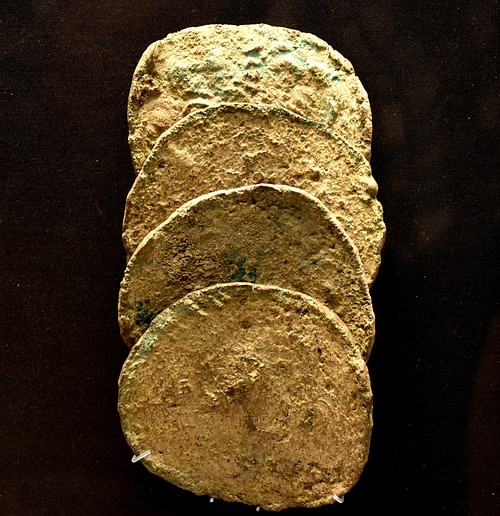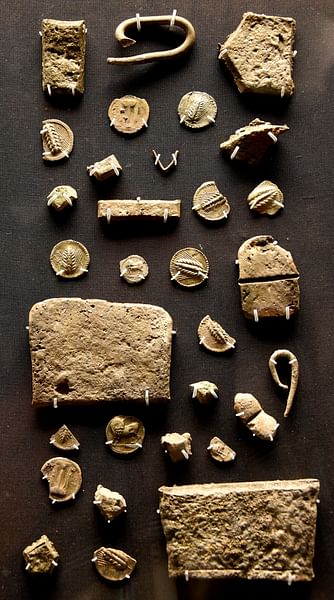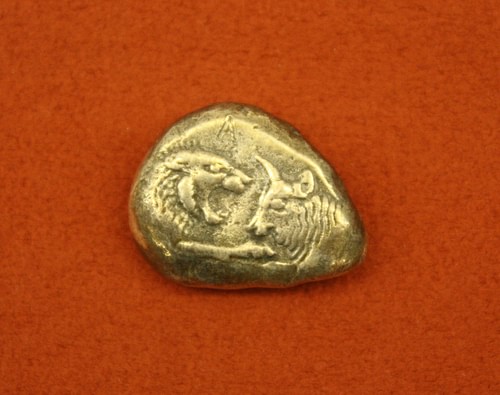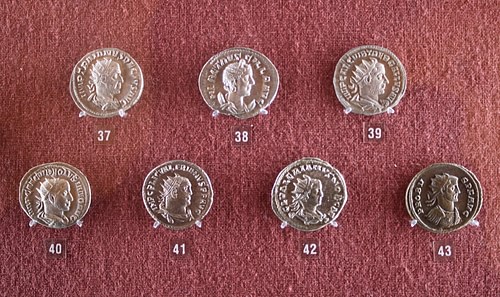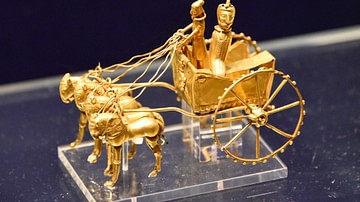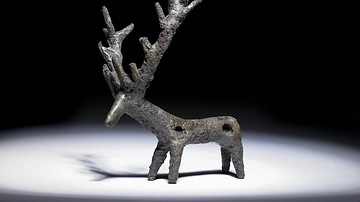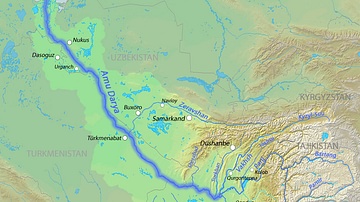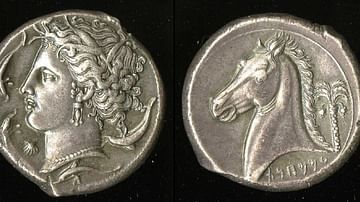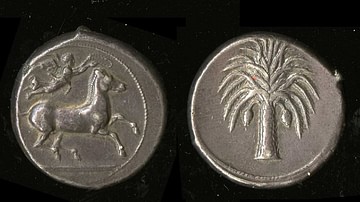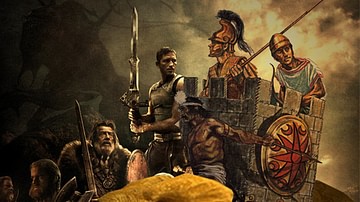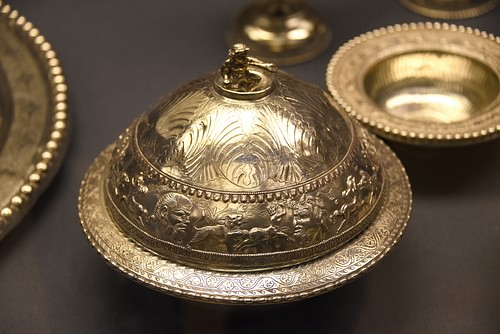
Silver had great value and aesthetic appeal in many ancient cultures where it was used to make jewellery, tableware, figurines, ritual objects and rough-cut pieces known as hacksilver which could be used in trade or to store wealth. The metal of choice to mint coinage for long periods, acquisition of silver mines in such places as Greece, Spain, Italy, and Anatolia was an important factor in many an ancient conflict. The metal was also found, amongst other places, in mines in ancient China, Korea, Japan, and South America where it was transformed into beautifully-crafted objects for elite use and to give as tribute and prestige gifts between states. Easily mined, worked, reusable, and brilliantly shiny, silver was one of the few truly international commodities which both connected and divided the ancient world.
Properties & Mining
Silver (Ag) is a soft metal which can be polished to produce an appealing lustre, two factors which made it ideal for ancient metalworkers to employ in their production of high-value goods. Silver was mined and smelted from ores such as lead carbonate (PbCO3) and galena (PbS). Ores usually contain less than 1% silver, but their abundance and lack of difficulty in smelting ensured ancient mining of the metal could be profitable, even from the Early Bronze Age. Smelting techniques improved over the centuries so that by the Classical period in Europe even low-grade ore could be exploited for the minute quantities of metal it contained. Indeed, smelting techniques made such progress that by Roman times it was possible to return to ore already treated (slag) in order to extract more silver from it. To strengthen the metal it was often alloyed with copper.
Mining of silver in the Americas was largely done by digging vertical shafts into the ground. These tended to be shallow and so many were dug along an area of silver-bearing ore. Individual horizontal shafts were similarly short, only around one metre in length. Broken up using antler tools, the ore was crushed and smelted in clay crucibles. The Americas did not have bellows, and so the high temperatures needed for smelting were usually provided by several people blowing into the fire through tubes. As elsewhere, charcoal was used as the fuel source. Andean metalworkers were specialists at silver-plating and at producing alloys which mixed silver with gold, copper, and even platinum. Finished works were then often gilded or even painted.
Geographical Availability
In Mesopotamia silver was used from the 4th millennium BCE. With no deposits in the area, silver was imported from Anatolia, Armenia, and Iran. Cities like Ugarit, Sumer, and Babylon used silver as a standard value measure with workers, for example, being paid in a specific weight of silver or its equivalent value in cereals. The Egyptians also valued silver and likewise acquired it through trade from Predynastic times, although silver archaeological finds are rarer than in other ancient cultures. This is perhaps because the Egyptians had their own sources of gold and only limited indigenous sources of silver. Certainly, silver was much closer in value to gold in ancient Egypt compared to other ancient cultures (1:2 instead of the more typical 1:13), and there were periods when it was considered even more valuable. In the Aegean, the Early Bronze Age cultures used silver which was mined from Attica (especially Laurion), the Cyclades, Thrace, and ancient Macedonia.
The Phoenicians, perhaps the greatest traders of them all, spread the use of silver even further across the ancient Mediterranean and channelled tons of it to western Asia, especially Assyria, mostly in the form of bullion (ingots, disks, and rings). The Phoenicians acquired such quantities that they earned an admonishing reference in the Bible: "Tyre heaped up silver" (Zechariah 9:2-3). To guarantee the weight and value, bars were stamped with official hallmarks. A Phoenician talent of silver weighed around 30 kilos and was worth 300 shekels. One silver shekel was worth 300 copper shekels and 227 shekels of tin. Gold was worth four times more than silver. Supply and demand affected the value of commodities just as they do today, and the oversupply of silver to the Near East caused a crash in the value of silver by the 6th century BCE.
Classical Athens benefitted from hitting a huge new seam on Mt. Pangaeus in Thrace, and both Carthage and Rome had a ready supply form Iberian mines and those on Sardinia. Indeed, the Romans worked some 40,000 slaves in the silver mines of Spain. The Etruscans did not go without, either, for they had access to silver in the north of their territory in Italy. By the later Roman period, as the empire expanded, silver was extracted from Britain, Germany, and the Balkans. Traded as coinage with peoples in India in exchange for spices and luxury goods, it was then converted back into bullion.
In the East, China's silver mines were exploited in the south from the 8th century CE, which led to the metal replacing silk as the primary method of bulk payment by merchants. In ancient Japan, silver was not extensively mined until the 16th century CE, but when it was, the metal became a handy method of payment with Portuguese traders who then spent it soon enough in their trade with China. So much silver went into the pockets of European traders - 20 tons a year - and the mines were worked out to such an extent that the Japanese government limited the silver taken out of the country from 1668 CE.
In the Americas, while the ancient Maya had plenty of gold, they had no silver of their own to speak of, but it was found in abundance further south, in the empires of the Incas and their predecessors. With plentiful supplies mined from northern South America (Colombia and Ecuador especially), the Moche, Wari, Lambayeque, and Chimu cultures all produced silverwork of the highest quality. For the Inca, just as gold was considered the sweat of the Sun, silver was thought of as the tears of the Moon. The rarity and prestige of the metal meant that it was restricted to use by the nobility; commoners had to make do with goods made from copper or bronze.
Uses of Silver
Not as valuable as gold, silver was, nevertheless, used for much the same purposes but on a grander scale. Most ancient cultures benefitted from specialised craftsmen, often working for the royal household and given a dedicated area of the city to produce their shiny wonders. Jewellery, utensils, vessels, dishes, pepper castors, saucepans, figurines, masks, and decorative objects were made in silver. Silver, because of its high value, was widely used in objects related to religious rituals such as incense burners, relics containers, and votive offerings or dedications. Textiles were embroidered with silver thread, and items of clothing had pieces of silver sewn onto them. The metal was also widely used as an inlay material in such items as weapons, armour, furniture, and metal vessels.
Hacksilver
Long before coins came along, silver in the form of ingots and rough cut pieces was a common method of payment for traders and states alike. This latter form, known as hacksilver (or hacksilber), was also used as a method to store wealth and was frequently buried, leading to spectacular archaeological finds of long-hidden hoards. Being roughly cut off from old jewellery, ingots, and basically anything made from pure silver, it was weighed each time a transaction was made, which often resulted in pieces being cut again and again to meet the exact weight required and, as a result, the pieces became ever smaller. The practice was common in the Near East, Egypt, and the ancient western Mediterranean up to the 4th century BCE when coinage largely replaced it. Hacksilver and silver ingots of no particular standardised weight were used in ancient India from the 8th to 7th century BCE. Small bent bars are typical, and judging by their differing weights, smaller pieces were probably cut from them before coinage became common.
Many hacksilver hoards include silver coins and so illustrate the gradual transition from one form of wealth storage to another. Spain, in particular, was an area where the habit of using hacksilver lingered on well into the 1st century BCE. With the demise of the Roman empire coinage production fell dramatically and hacksilver was, once again, the primary means to keep wealth and pay for goods. The Vikings, especially, were great savers of chopped up silver bits if the quantity of hoards discovered across central Europe, Britain, and Scandinavia are anything to go by.
Silver Coinage
One of the most common uses of silver throughout antiquity was as coinage. During the 6th century BCE, the first coins were minted in Lydia, which were made of electrum, a natural alloy of gold and silver, or of pure gold or pure silver. They were stamped with a design by the state as a mark of their authenticity and weight.
The first Greek coins appeared at Aegina c. 600 BCE (or even earlier), which were silver and used a turtle design as a symbol of the city's prosperity based on maritime trade. Athens and Corinth soon followed Aegina's lead. Heated discs of silver were hammered between two dies engraved with the designs. The birth of coinage in wider Greece, though, was not really an invention of convenience but a necessity, driven by the need to pay mercenary soldiers. These warriors required a convenient way to carry their wages, and the state needed a method of payment they could equally apply to everyone.
Around 510 BCE Darius I introduced coinage in Persia, which included the silver shekel which weighed around 5.5 grammes. The master traders the Phoenicians long preferred the universal acceptability of silver bullion wherever their trade tentacles reached but, eventually, they too succumbed to progress. The first Phoenician coins were minted at Kition c. 500 BCE, then at Byblos c. 470 BCE. Other cities soon followed suit, Sidon and Tyre introducing silver coins around 450 BCE.
Coinage solved one problem but posed another, raising the interesting question of metal purity. The ancients were not aware of the concept of elements and their inherent properties, but smelters, through the necessity of creating coinage that was of a standardised weight, did manage to reach a purity of silver of around 98%. Silver coins were of relatively high value, perhaps equal to one week's work for most citizens. Only in the Hellenistic Period did smaller denominations become more widespread.
The first Roman silver coins were produced from the early 3rd century BCE and resembled contemporary Greek coins. C. 211 BCE a whole new coinage system was introduced. Appearing for the first time was the silver denarius (pl. denarii), a coin that would be the principal silver coin of Rome until the 3rd century CE. Following the acquisition of the silver mines in Macedonia from 167 BCE, there was a huge boom in silver coins from 157 BCE. Gradually, as emperors spent more frivolously and wars drained the state coffers, silver coins went from almost pure to 70% then 50% and on down until they reached an all-time low of just 2% silver content.
Chinese coins, with their distinctive square central hole, were first produced in the second half of the first millennia BCE, but they were always made of copper. Coinage arrived in ancient India around the 6th century BCE. The ancient Americas had no coinage, but silver, like other precious materials such as gold and textiles, was used for trading purposes. Silver was highly valued and goods made from it were used as gifts and tribute, but their specific value depended on each item and the context in which it was given.
One final form of currency, in use in Korea from the 12th to 14th century CE, was the unbyong silver vase, stamped by the state and given an official rate of exchange with staple commodities such as rice; it was shaped like the peninsula of Korea. Unfortunately, no examples survive, but we do know from a 1282 CE law that the value of one unbyong was fixed at between 2,700 and 3,400 litres of rice. Despite their impracticality for smaller transactions, the vases continued to be used over the next two centuries, until King Chungyol permitted rough or broken pieces of silver to be used instead at the end of the 13th century CE.
